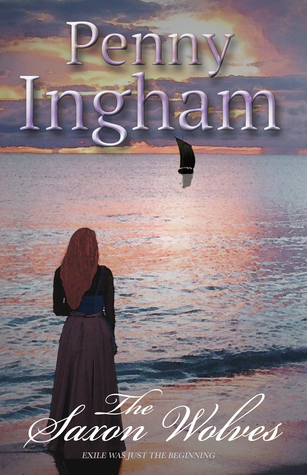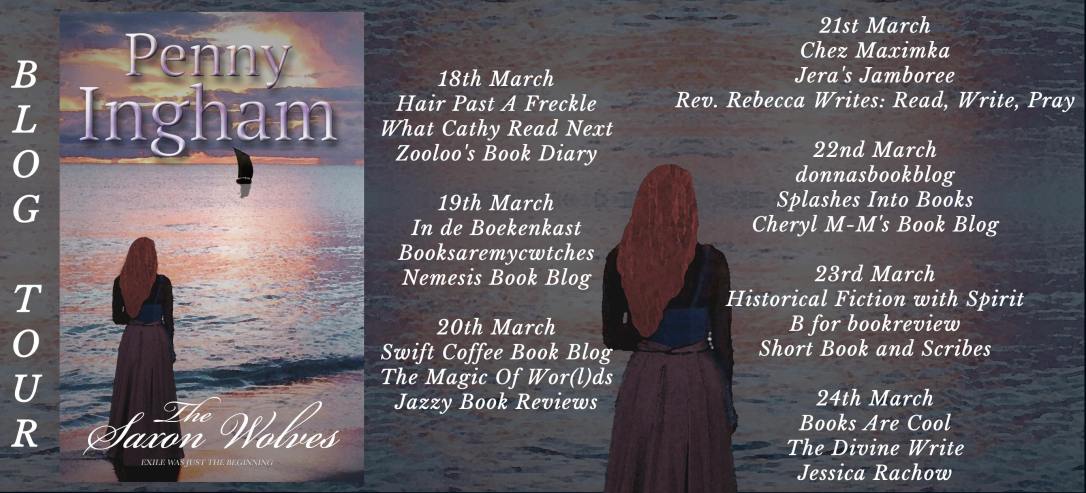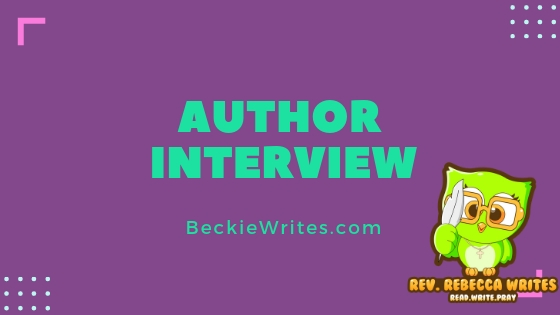The Saxon Wolves by Penny Ingham takes readers on an epic journey into Britain’s Dark Ages.
For Anya, exile is only the beginning.
\
The Saxon Wolves Book Details
Title:The Saxon Wolves
Author: Penny Ingham
Genre: Historical Fiction
Length: 420 pages
Format: I read this book for free on Amazon’s Kindle Unlimited
Grab your own copy:
UK – https://www.amazon.co.uk/Saxon-Wolves-Exile-just-beginning-ebook/dp/B01L5NCDGE
US – https://www.amazon.com/Saxon-Wolves-Exile-just-beginning-ebook/dp/B01L5NCDGE
Synopsis of The Saxon Wolves

Britain 455AD.
The Roman Empire has fallen.
As the daughter of a king and a priestess of the sacred grove, Anya’s life in Germania is one of wealth and privilege – until she dares to speak out against the high priest’s barbaric human sacrifices. Her punishment is exile. Forced to leave her homeland, she sails to Britannia, to an island is sliding into chaos and war, as rival kingdoms vie for power. Alone and far from home, Anya must learn to survive amidst the bloodshed, treachery and intrigue of fifth century Britain. Can she find a place to belong – a home, a hearth, a welcome
My Review of The Saxon Wolves

I absolutely loved The Saxon Wolves by Penny Ingham. I loved this book so much that as soon as I was finished, I went straight to Kindle Unlimited and downloaded the sequel, The Saxon Plague.
The Saxon Wolves was a book that I didn’t realize was missing from my life until I read it. Growing up, I was a huge fan of Marion Zimmer Bradley (I still am) and I devoured her books. I didn’t realize how much I missed getting lost in the pages of an epic historical saga until I found myself once more neck deep in the excitement of Brittainia’s Dark Ages.
Ingham’s characters breathe new life into the Dark Ages!
I loved Anya as a character. She is both a religious leader and a princess. She is so well developed that she feels like flesh and blood. By the time I got to the end of the book, I absolutely needed to know what happened next to Anya.
The entire cast of characters are well developed and engaging. Ingham brings the Dark Ages to life in a way that I haven’t experienced in a very long time. I felt as if I was transported from my comfortable home in rural Pennsylvania to the turbulent world of the third century.
Ingham’s work is historical fiction at its finest!
I was fascinated by Ingham’s exploration of the rise of Christianity in the Anglo Saxon World. I’ve read many historical accounts of how Christianity became one of the dominant world religions, but Ingham’s account of the crumbling remains of the Roman empire breathed new life into the historical narrative for me.
When I picked up The Saxon Wolves, I did not realize that it was going to have a sequel; however, as the book drew to a close, I knew that I really wanted to know the rest of Anya’s story. While Anya’s story is definitely complete by the end of The Saxon Wolves, it was by no means “finished.”
Normally, I try not to start new book series. My job is too busy and my life is just too hectic to commit myself to an ongoing series. I will often pass on reading a book simply because I do not want to start another series. I’m so glad that I did not pass on The Saxon Wolves.
This is one epic adventure you won’t want to miss!
It’s been about a week since I finished reading The Saxon Wolves, and I just can’t get the story out of my head. I keep wondering what happened to Anya, Rufus, and Vortigen. Ingham’s writing is historical fiction at it’s finest. If you love a good epic saga and if you long to explore (if even for a few hours) the world as King Arthur once knew it, then The Saxon Wolves is one adventure that you won’t want to miss!
TW: This is the Dark Ages, so be aware that this book does include a historical representation of themes of violence and the threat of violence against women.
*Note: Thank you to the author and to Rachel at Rachel’s Random Resources for a free digital copy of this book in exchange for an honest review. I also read this book on Kindle Unlimited. All opinions expressed in this review are my own.
My Interview with Penny Ingham

Rev. Rebecca: I would just like to say that I really enjoyed reading The Saxon Wolves. One of my favorite things about reading well written historical fiction is that I get to learn a lot about the people and the cultures of the past. I could tell from the very beginning that your book was impeccably researched.
Could you share a little bit about your research methods? When you wrote The Saxon Wolves, what came first: the plot, the characters, or some other seed of inspiration?
Penny Ingham: First of all, I am delighted you enjoyed The Saxon Wolves! Researching the novel meant thinking outside the box, for just one near-contemporary account survives for post Roman Britain. I pored over Gildas’ account very closely, and it is his version of events that I took for the basic framework of the novel. Early medieval war poetry, including Beowulf and the Battle of Brunanburgh, proved a wonderful source of inspiration for my battle scenes. Advances in the science of archaeology are giving us valuable insights into the Saxon world – the homes they lived in, the food they ate, even their DNA. Discoveries like the Staffordshire Hoard paint a vivid picture of the wealth and splendor of the warrior elite, whilst recent excavations at Tintagel in Cornwall have proved there was a high status fortification on the clifftop at the time a historic ‘Arthur’ would have been fighting the Saxon invaders.
The Saxon Wolves is set in 455AD. The Romans had withdrawn from Britain, but their towns, villas, forts etc, were still very much in evidence, even if they were starting to look a little worse for wear! In fact, much survives to this day, and I was lucky enough to visit all the Roman sites featured in the novel during the course of my research.
I’m an amateur archaeologist, and have ‘dug’ at many sites in the British Isles, including Fishbourne Roman Palace and Silchester Roman town. Finding a Roman coin or a piece of pottery that has not been touched by human hands for two thousand years is a tangible link to the past, and my ‘digs’ often inspire my writing.
Without a doubt, the historic site of Tintagel was a huge source of inspiration for The Saxon Wolves. I can remember standing on the clifftop, looking out to sea, breathing in the smell of salt and fish and seaweed, and trying to imagine how it might have felt to live at the very edge of the known world. And from there, the plot and the characters started to fall into place.
Rebecca: I know that in your author’s note you said that Anya’s story is fictional, but I also realize that many elements of her tale are drawn from historical fact. I’m also particularly fascinated by the role of women in religion. I love how Anya is both a priestess and a princess. Where did you find the inspiration for Anya’s story?
Penny: We still don’t fully understand why, or how, over the course of four hundred years, the Anglo Saxons became the dominant force in England. In The Saxon Wolves, I wanted to explore this period of great upheaval, of migration and clashing cultures, through the eyes of both the local Britons and the incoming Saxons. Once I had decided my main protagonist was to be a Saxon, I looked to the flat plains of northern Germany for inspiration. The epic poem Beowulf with its evocative depictions of golden feasting halls, noble kings and faithful retainers, brought Anya’s kingdom of Saxony vividly alive for me. And then I turned to the Roman writer, Tacitus, who writes in great detail about the pagan rituals and Druid priests of the ancient Germanic people. I quickly became fascinated by their religion, and it just felt ‘right’ that Anya would be both a princess and a Druid priestess.
Rebecca: One of the things I really appreciated about The Saxon Wolves was the wealth of details and the story’s rich historical realism. I felt as if I was actually there. As a writer, how do you weave historical fact with fiction? How do you decide when to take poetic license and when to hold fast to the facts?
Penny: For me, historical fiction is like time travel, but from the comfort, and safety, of my own armchair. When I’m reading a historical novel, I want to be entertained, but I also want to feel as if I’m learning something about the period. So when I’m writing my own novels, I try very hard to get my facts right, to be as true to the time and the place as possible. As a general rule of thumb, I hold fast to the general outline of historical events in all my novels. They are the bare bones, the foundations if you like, for me to build upon. It is how my characters react to those events that will hopefully bring my story alive.
Rebecca: As soon as I finished The Saxon Wolves, I downloaded the sequel on Kindle Unlimited. I can’t wait to know more of Anya’s story. Could you share a little bit about what readers can expect to find in the sequel? Will Anya’s story be concluded in the second book? Are you planning a third book in the series?
Penny: The Saxon Wolves explores Anya’s life as an exile. She loses everything – her home, her family, her place in society – but somehow she has to find a way forward, a way to survive. In the sequel, The Saxon Plague, she continues her search for a place to belong. But Britain is sinking into chaos and war. Both Saxon and British blood flows in her veins, and Anya must choose where her loyalties lie. With the people of Britannia? With her Saxon kin? Or with the man she secretly loves – Silvanus, heir to the throne of Dumnonia?
A third book is entirely possible!
Rebecca: I have to ask: Will we see more of Rufus in the second book? He was my favorite secondary character and so richly complex.
Getting inside Rufus’s head took me to some very dark places – he’s so tragically damaged. And yes, he plays a pivotal role in the second book.
Rebecca: Another of my favorite aspects of the book was how it explored the religious zeitgeist of the Dark Ages (which we now know weren’t nearly as Dark as we originally thought). Could you share a little bit more about your understanding of how Christianity became the dominant religion in the region?
Penny: Such a fascinating subject! It’s open to debate just how ‘Christianised’ Roman Britain actually was. It seems likely that vast swathes of the island, particularly the rural areas, held fast to their pagan beliefs – after all, the word pagan means ‘of the countryside’. Once the Romans departed, Christianity largely faded away in England, assisted by the spread of the incoming pagan Saxons. It wasn’t until about 600AD, with the arrival of Augustine and his missionaries from Rome, that Christianity once again began to gain a foothold. According to Bede, this began in the kingdom of Kent, with the conversion of King Aethelberht. It seems his Frankish wife was already a Christian.
I like to think women played a large part in the spread of Christianity. Political marriages often meant women traveled huge distances to distant kingdoms, where they passed on their cultural identities and religious beliefs to their husbands and children. The Christian missionaries were very clever in how they ‘sold’ their religion to the pagan Saxons. Rather than insisting the British turned their backs on the ‘old’ religion, they often superimposed Christian festivals upon pre-existing pagan rites, and transformed the sacred sites of the water gods into ‘holy wells.’ For a while, it seems the Saxons hedged their bets – the Sutton Hoo ship burial includes both pagan and Christian grave goods – but once the aristocratic elite began to wholeheartedly embrace Christianity, it could well have become the fashionable choice, a mark of civilized society.
Rebecca: Finally, are you working on any other projects at the moment? Are you writing another book or doing research? What are you most excited about right now?
Penny: I am currently writing a novel set in sixteenth century London. On the one hand, it was such an exciting, glamorous, innovative period. On the other hand, it was dark, dangerous and bloody. I am loving every minute of it!
About the Author: Penny Ingram

Penny’s father, a journalist, instilled her with a love of history from an early age. Family holidays invariably included an invigorating walk up an Iron Age hill-fort whilst listening to his stirring stories of the Roman attack and the valiant defence by the Britons. Consequently, Penny has a degree in Classics and a passion for history and archaeology. She has enjoyed a varied career, including BBC production assistant, theatre PR and journalism, but her ambition was always to write historical fiction. Her first novel, The King’s Daughter, was awarded Editor’s Choice by the Historical Novel Society. Penny has worked on many archaeological excavations, and these ‘digs’ and their evocative finds often provide the inspiration for her books. Penny’s research also takes her to the many spectacular historical sites featured in this novel, including Hadrian’s Wall and Tintagel.”
Follow Penny Ingham!
Twitter – @pennyingham
Facebook – https://www.facebook.com/TheSaxonWolves/
Instagram – https://www.instagram.com/pennyinghamthesaxonwolves/
Website – pennyingham.wordpress.com

Please make sure that you subscribe to my blog so that you never miss a post! You can also follow me on Instagram and Twitter!



A fascinating review and am interesting interview to read! 😻 I couldn’t resist immediately downloading the sequel either 😅 I just had to read Anya’s story forward. I would so love if there would be a third book one day!
LikeLike
Oh, wow! Does this book finally gibe Anya an ending? I can’t wait!
LikeLiked by 1 person
Well, kind of 😀 it’s way more of a closure than the ending of the first book, but I see clearly the plot lines that could be unfolded even further!
LikeLiked by 1 person
Oh, I can’t wait to read it!
LikeLiked by 1 person